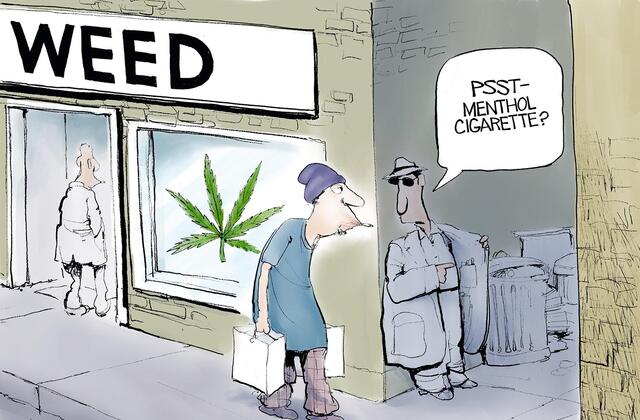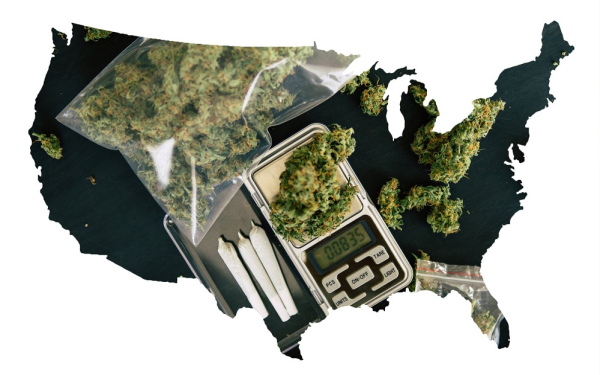U.S. Marijuana Legalization Process

In fact in the United States marijuana has gone through a long road from illegal and strict to gradually relaxed to partially legal. Many states restricted marijuana as a drug beginning in 1906, and outright prohibition began in the 1920s. By the mid-1930s, marijuana was considered a class controlled substance in every state, including 35 states that had adopted national uniform narcotic drug laws. The U.S. government passed the Marijuana Act, which made it illegal to smoke marijuana in 1995. In the 1970s, state laws and other local regulations banning the possession or sale of marijuana began to be revoked in many parts of the United States, and the same thing happened in the 1990s with the sale of marijuana for medical purposes. All of this conflicts with federal law, which classifies marijuana, along with heroin, as a Class I drug under the Controlled Substances Regulations of 1970.
The wave of initiatives to legalize marijuana began in 2012 and has been largely driven by coastal states. About two-thirds of U.S. adults support legalizing marijuana, according to a 2019 Pew Research Center survey, and more states are likely to join them in the coming years.
States have been setting their own guidelines for the legality of marijuana use and the amount they consider legal for residents to possess. However, at the federal level, the DEA continues to classify marijuana as a Schedule I drug with "no currently accepted medical use and a high potential for abuse."Below are the 18 states that have legalized marijuana for recreational use as of January 2021. The states are listed in order of when their legalization measures were approved.
Colorado
Legalized in 2012
Adults in Colorado can possess up to 1 ounce of marijuana and can grow up to six plants at home. The state specifies that counties and municipalities can pass stricter laws.
Washington
Legalized in 2012
In Washington, adults can purchase up to 1 ounce of usable marijuana, meaning it’s in the form of harvested flowers. They can buy up to 16 ounces of marijuana-infused edibles, 72 ounces of marijuana in liquid form and 7 grams of marijuana concentrates.
While many states ban people from driving under the influence of any amount of marijuana, Washington has a limit of 5 nanograms of THC, the psychoactive chemical ingredient in marijuana, per milliliter of blood.
Alaska
Legalized in 2014
Alaskans can grow up to six marijuana plants in their home, but only three of the plants can be flowering at any time.
Oregon
Legalized in 2014
Oregon residents can keep up to 8 ounces of marijuana and four marijuana plants in their home, and they can have up to 1 ounce of marijuana on their person while in public.
On Election Day 2020, Oregon voters also decriminalized hard drugs including cocaine, methamphetamine and heroin, while authorizing psychedelic mushrooms for medicinal use.
California
Legalized in 2016
Californians can have up to 1 ounce of cannabis, up to 8 grams of concentrated cannabis and up to six cannabis plants, which must be grown at home.
Maine
Legalized in 2016
Maine’s law allows residents to have up to 2.5 ounces of marijuana, which may include up to 5 grams of marijuana concentrate. People can also have up to six “flowering marijuana plants” and “12 immature plants and unlimited seedlings,” according to the state’s website.
Massachusetts
Legalized in 2016
In Massachusetts, people can have 10 ounces of marijuana in their home, but anything over 1 ounce must be locked up. Residents can grow up to six plants at home, and marijuana is prohibited on public or federal land.
Nevada
Legalized in 2016
Nevadans can possess up to 1 ounce of marijuana and up to one-eighth of an ounce of concentrated marijuana. They can grow up to six plants per person, or 12 plants per household.
Vermont
Legalized in January 2018
Vermont was the first state to legalize marijuana through its Legislature instead of through a ballot measure. Residents can possess up to 1 ounce of cannabis and each household is allowed two mature and four immature marijuana plants.
Michigan
Legalized in 2018
Michigan residents can possess up to 2.5 ounces of cannabis and can grow as many as 12 plants, as long as they are hidden from the public.
As of 2020, the state has operational retailers where patrons can purchase cannabis for recreational use, and provisioning centers for medical use.
Illinois
Legalized in June 2019
Illinois followed Vermont’s lead, legalizing cannabis possession through its legislature instead of a ballot measure. Under the law, which went into effect in January 2020, residents can possess up to 30 grams of cannabis flower and 5 grams of cannabis concentrate.
New Jersey
Legalized in 2020
Voters in New Jersey approved a ballot initiative to legalize marijuana by nearly 67% on Election Day 2020. The text of the measure stipulates that only adults over the age of 21 would be able to use cannabis. It authorized the existing state commission on medical cannabis to govern the market for recreational use, and made the cannabis trade subject to state and local taxes. Legalization went into effect Jan. 1, 2021.
Montana
Legalized in 2020
On Election Day 2020, Montana featured two popular vote measures that would regulate the use of recreational marijuana. Montana Initiative 190 – which legalized the possession and use of limited amounts of cannabis by adults 21 and over – was approved by nearly 57% of voters, according to the Montana secretary of state. Montana Constitutional Initiative 118 – which allows the state Legislature to set an age for marijuana use and consumption – passed with 58% of the vote.
Arizona
Legalized in 2020
Arizona’s Proposition 207 would allow limited marijuana use, possession and cultivation by adults over age 21; ban smoking in public; establish state and local regulation of marijuana licenses; and allow marijuana offenses to be expunged. About 60% of voters supported the measure on Election Day 2020.
New York
Legalized in 2021
After Gov. Andrew Cuomo’s signing of the Marihuana Regulation and Taxation Act on March 31, individuals age 21 and older will be able to possess up to 3 ounces of recreational cannabis. The state will establish two regulatory bodies to manage the sale of adult-use marijuana.
Virginia
Legalized in 2021
On April 7, 2021, both chambers of Virginia’s General Assembly passed SB1406, with amendments put forth by Gov. Ralph Northam. Since the legislature approved the governor’s amendments, no further action was needed to enact the law, a staff member for Northam confirmed. The amended legislation will allow Virginians age 21 or older to possess up to 1 ounce of recreational marijuana as of July 1, 2021. While the law will also allow residents to grow up to four cannabis plants, the measure as enacted doesn’t establish a framework for licensing retail sales of adult-use marijuana.
New Mexico
Legalized in 2021
Gov. Michelle Lujan Grisham signed the legalization measure HB2 into law on April 12. The law went into effect on June 29, allowing adults over age 21 to possess up to two ounces of cannabis outside their homes and grow up to 12 total marijuana plants per household, according to Regulation and Licensing Superintendent Linda Trujillo.
Connecticut
Legalized in 2021
On June 22, Gov. Ned Lamont signed the state’s marijuana legalization bill, SB1201. Starting July 1, individuals over age 21 will be able to possess up to 1.5 ounces of recreational cannabis in public, as well as another five ounces in a secured container at home or in a vehicle. Low-level marijuana offenses will be expunged under the law. The state will establish regulatory guidelines before launching retail sales in full around the summer of 2022, at the earliest.


